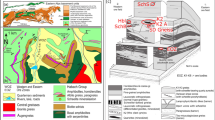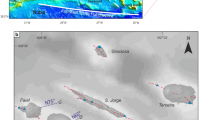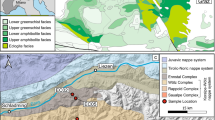Abstract
The activity of the Damavand volcano (Central Alborz, northern Iran) began 1.8 Ma ago and continued up to 7 ka BP. Although the volcanic suite is clearly of shoshonitic affinity, only two petrographic types can be distinguished in the studied lavas: (1) weakly differentiated absarokites (49 < %SiO2 < 51), scattered around the volcano but with a regional extension, (2) highly differentiated banakites (59 < %SiO2 < 63), which form the bulk of the 4,000 m thick volcanic pile. All lavas are alkalic (3.7 < %K2O < 5), REE and LILE-rich (e.g., 85 < La < 148 ppm; 9 < Th < 32 ppm) and show highly fractionated REE patterns (69 < La/Yb < 115) and pronounced Nb–Ta negative anomalies. The absarokites are characterised by Sr (0.7045–0.7046) and Nd (0.51266–0.51269) isotope compositions close to the Bulk Earth values, and distinct from those of the banakites (0.7047 < 87Sr/86Sr < 0.7049, 0.51258 < 143Nd/144Nd < 0.51262). The Pb isotope ratios are also slightly lower in the absarokites than in the banakites (18.71 < 206Pb/204Pb < 18.77, 15.62 < 207Pb/204Pb < 15.63, 38.85 < 208Pb/204Pb < 38.91, and 18.77 < 206Pb/204Pb < 18.84, 15.62 < 207Pb/204Pb < 15.64, 38.94 < 208Pb/204Pb < 39.06, respectively). Overall, there is a clear tendency towards higher Sr, Pb and lower Nd isotope ratios with increasing degree of differentiation. This study suggests that the absarokites result from a low degree of partial melting (∼5%) of a highly metasomatized mantle source, which inherited its characteristics from an old subduction setting. The initiation of volcanic activity 1.8 Ma ago results from variations in the lithospheric thermal regime, probably related to lithospheric delamination as proposed for Anatolia (Pearce et al. 1990). The banakites are mainly generated by extensive fractional crystallisation (∼70%) of the absarokitic magma, with a limited amount (a few percents) of assimilation of an old crustal component, in the form of bulk assimilation or AFC processes, which both can explain the Sr, Nd and Pb isotope data.






Similar content being viewed by others
References
Aftabi A, Atapour H (2000) Regional aspects of shoshonitic volcanism in Iran. Episodes 23:119–125
Allègre C J, Condomines M (1976) Fine chronology of volcanic processes using 238U–230Th systematics. Earth Planet Sci Lett 28:395–406
Allen MB, Ghassemi MR, Shahrabi M, Qorashi M (2003) Accomodation of the late Cenozoic oblique shortening in the Alborz range, northern Iran. J Struct Geol 25:659–672
Allenbach P (1966) Geologie und Petrographie des Damavand und seiner Umgebung (Zentral-Elbruz, Iran). Mitt Geol Inst ETH, Univ. Zürich 63, pp 114
Babaie HA, Ghazi AM, Babaie A, La Tour TE, Hassanipak AA (2001) Geochemistry of arc volcanic rocks of the Zagros Crush Zone, Neyriz, Iran. J Asian Earth Sci 19:61–76
Beccaluva L, Di Girolamo P, Serri G (1991) Petrogenesis and tectonic setting of the Roman volcanic province, Italy. Lithos 26:191–221
Ben Othman D, White WM, Patchett J (1989) The geochemistry of marine sediments, island arc magma genesis, and crust-mantle recycling. Earth Planet Sci Lett 94:1–21
Berberian M, King GC (1981) Towards a paleogeography and tectonic evolution of Iran. Can J Earth Sci 18:210–265
Bickle MJ, Bettenay LF, Chapman HJ, Groves DI, McNaughton NJ, Campbell IH, de Laeter JR (1989) The age and origin of younger granitic plutons of the Shaw Batholith in the Archaean Pilbara Block, Western Australia. Contrib Mineral Petrol 101:361–376
Boulin J (1991) Structures in Southwest Asia and evolution of the eastern Tethys. Tectonophysics 196:211–268
Bourdon E, Eissen J-P, Gutscher M-A, Monzier M, Hall ML, Cotten J (2003) Magmatic response to early aseismic ridge subduction: the Ecuadorian margin case (South America). Earth Planet Sci Lett 205:123–138
Bout P, Derruau M (1961) Le Demavend. C.N.R.S., Paris, Mém. et Doc. 8:9–102
Brousse R, Vaziri HM (1982) L’association shoshonitique du Damavand (Iran). Geologische Rundschau 71(2):687–702
Brousse R, Lefèvre C, Maury RC, Vaziri HM, Sobahni EA (1977) Le Damavand: un volcan shoshonitique de la plaque iranienne. C R Acad Sci Paris Série D 285:131–133
Condomines M, Tanguy JC, Michaud V (1995) Magma dynamics at Mt Etna : constraints from U–Th–Ra–Pb radioactive disequilibria and Sr isotopes in historical lavas. Earth Planet Sci Lett 132:25–41
D’Antonio M, Tilton GR, Civetta L (1996) Petrogenesis of Italian alkaline lavas deduced from Pb–Sr–Nd isotope relationships. In: Basu A, Hart S (eds) Earth processes: reading the isotopic code. AGU, Washington DC, pp 253–267
Davidson JP, McMillan NJ, Moorbath S, Worner G, Harmon RS, Lopez-Escobar L (1990) The Nevados de Payachta volcanic region (18°s, 69°W, N. Chile): II. Evidence for widespread crustal involvement in Andean magmatism. Contrib Miner Petrol 105:412–432
Davidson J, Hassanzadeh J, Berzins R, Stockli DF, Bashukooh B, Turrin B, Pandamouz A (2004) The geology of Damavand volcano, Alborz Mountains, northern Iran. GSA Bull 116(1/2):16–29
De Astis G, Peccerillo A, Kempton PD, La Volpe L, Wu TW (2000) Transition from calc-alkaline to potassium-rich magmatism in subduction environments: geochemical and Sr, Nd, Pb isotopic constraints from the island of Vulcano (Aeolian arc). Contrib Mineral Petrol 139:684–703
Edwards CMH, Menzies MA, Thirlwall MF, Morros JD, Leeman WP, Harmon RS (1994) The transition to potassic alkaline volcanism in islands arcs : the Ringgit–Beser complex, East Java, Indonesia. J Petrol 35:1557–1595
Edwards C, Menzies MA, Thirlwall M (1991) Evidence from Muriah, Indonesia, for the interplay of supra-subduction zone and intraplate processes in the genesis of potassic alkaline magmas. J Petrol 32:555–592
Ellam RM, Hawkesworth CJ, Menzies MA, Rogers NW (1989) The volcanism of Southern Italy: role of subduction and the relationship between potassic and sodic alkaline magmatism. J Geophys Res 94:4589–4601
Gasperini D, Blichert-Toft J, Bosch D, Del Moro A, Macera P, Albarède F (2002) Upwelling of deep mantle through a plate window: Evidence from the geochemistry of Italian basaltic volcanics. J Geophys Res 107 B12:ECV7 1–19
Gauthier PJ, Condomines M (1999) 210Pb-226Ra radioactive disequilibria in recent lavas and radon degassing: inferences on the magma chamber dynamics at Stromboli and Merapi volcanoes. Earth Planet Sci Lett 172:111–126
GERM (Geochemical Earth reference Model) home page. http://www.earthref.org
Green T.H. (1995) Significance of Nb/Ta as an indicator of geochemical processes in the crust-mantle system. Chem Geol 120:347–359
Gülen L (1984) Sr, Nd, Pb isotopes and trace element geochemistry of calc-alkaline volcanics of eastern Turkey. PhD, MIT, Cambridge, pp 232
Guo Z, Hertogen J, Liu J, Pasteels P, Boven A, Punzalan L, He H, Luo X, Zhang W (2005) Potassic magmatism in western Sichuan and Yunnan provinces, SE Tibet, China. J Petrol 46:33–78
Hickey RL, Frey FA, Gerlach DC, Lopez-Escobar L (1986) Multiple sources for basaltic arc rocks from the Southern Volcanic Zone of the Andes (34 degrees -41 degrees S); trace element and isotopic evidence for contributions from subducted oceanic crust, mantle, and continental crust. J Geophys Res 91:5963–5983
Innocenti F, Manetti P, Mazzuoli R, Pasquaré G, Villari L (1982) Anatolia and north-western Iran. Andesites. Wiley, Chichester, pp 327–349
Ionov DA, Savoyant L, Dupuy C (1992) Application of the ICP-MS technique to trace element analysis of peridotites and their minerals. Geostandard Newsl 16:311–315
Jackson J, Priestley K, Allen M, Berberian M (2002) Active tectonics of South Caspian Basin. Geophys J Int 148:214–245
Jérémine E (1942) Sur quelques roches du Demavend (Perse). C R Acad Sci Paris 215:163–165
Mahéo G, Guillot S, Blichert-Toft J, Rolland Y, Pêcher A, (2002) A slab breakoff model for the Neogene thermal evolution of South Karakorum and South Tibet. Earth Planet Sci Lett 195:45–58
Maza M (1998) Transition entre magmatisme tholéiitique et alcalin en contexte intracontinental; exemple du point chaud du Hoggar. Thesis, Univeristy of Montpellier II, pp 1–216
Mehdizadeh H, Liotard JM, Dautria JM (2002) Geochemical characteristics of an intracontinental shosonitic association : the example of the Damavand volcano, Iran. CR Geosci 334:111–117
Pearce JA, Bender JF, De Long SE, Kidd WSF, Low PJ, Guner Y, Yilmaz Y, Moorbath S, Mitchell JG (1990) Genesis of collisional volcanism in eastern Anatolia, Turkey. J Volcan Geoth Res 44:189–229
Peccerillo A, Taylor SR (1976) Geochemistry of Eocene Calc-alkaline volcanic rocks from Katsamonu Area, northern Turkey. Contrib Mineral Petrol 68:63–81
Priestley K, Baker C, Jackson J (1994) Implications of earthquake focal mechanism data for the active tectonics of the south Caspian basin and surroundings regions. Geophys J Int 118:111–141
Ritz J-F, Balescu S, Soleymani S, Abbassi M, Nazari H, Feghhi K, Shabanian E, Tabassi H, Farbod Y, Lamothe M, Michelot J-L, Massault M, Chery J, Vernant P (2003a) Geometry, Kinematics and Slip Rate Along the Mosha Active Fault, Central Alborz, EGS-AGU-EUG Joint Assembly, Nice, France, 06–11 April 2003, Abstract EAE03-A-06057
Ritz J-F, Balescu S, Soleymani S, Abbassi M, Nazari H, Feghhi K, Shabanian E, Tabassi H, Lamothe M, Michelot J-L, Massault M (2003b) Determining the Holocene slip rate along the Mosha Fault, Central Alborz. In: 4th international conference on seismology and earthquake engeneering, 12–14 May 2003, Tehran
Rudnick RL (1995) Nature and composition of the continental crust: a lower crustal perspective. Rev Geophys 33:267–309
Sahandi M, Soheili M (2005) Geological Map of Iran at 1/1 000 000. Geol. Survey of Iran
Seghedi I, Downes H, Pécskay Z, Thirwall M, Szakacs A, Prychodko M, Mattey D (2001) Magmagenesis in a subduction-related post-collisional volcanic arc segment: the Ukrainian Carpathians. Lithos 57:237–262
Steiger RH, Jäger E (1977) Subcommission on geochronology, convention on the use of decay constants in geo- and cosmochronology. Earth Planet Sci Lett 36:359–362
Sun SS, McDonough WF (1989) Chemical and isotopic systematic of oceanic basalt: Implication for mantle composition and process. In: Saunders and Norry (eds). Magmatism in Ocean Basins. Blackwell, Geol Soc Spec. Publ, pp 313–346
Sun C-H, Stern RJ (2001) Genesis of Mariana Shoshonites: contribution of the subduction component. J Geophys Res 106:589–608
Tatsumi Y, Koyaguchi T (1989) An absarokite from a phlogopite lherzolite source. Contrib Mineral Petrol 102:34–40
Todt W, Cliff RA, Hanser A, Hofmann AW (1995) Evaluation of a 202Pb–205Pb double spike for high precision lead isotope analysis. In: Basu A, Hart S (eds) Earth Processes: reading the isotopic code. Geophys Monogr, American Geophysical Union 95:429–437
Turner S, Arnaud N, Liu J, Hawkesworth C, Harris N, Kelley S, Van Calsteren P, Weng W (1996) Post-collision shoshonitic volcanism on the Tibetan plateau: implications for convective thinning of the lithosphere and the source of ocean island basalts. J Petrol 37:45–71
Vernant P, Nilforoushan F, Chery J, Bayer R, Djamour Y, Masson F, Nankali H, Ritz J-F, Sedighi M, Tavakoli F (2004) Deciphering oblique shortening of Central Alborz in Iran using geodetic data. Earth Planet Sci Lett 223:177–185
Vollmer R, Hawkesworth CJ (1980) Lead isotopic composition of the potassic rocks from Roccamonfina (South Italy). Earth Planet Sci Lett 47:91–101
White WM, Albarède F, Telouk P (2000) High precision analysis of Pb isotope ratios by multi-collector ICP-MS. Chem Geol 167:257–270
Woodhead JD (1989) Geochemistry of the Mariana Arc (western Pacific); source composition and processes. Chem Geol 76:1–24
Acknowledgments
We thank Pierre Boivin (LMV, Université Blaise Pascal, Clermont-Ferrand) for generously providing his program for crystal fractionation calculations using major elements. We will also thank P. Brunet (LMTG, Toulouse University) who did the Sr isotope measurements and P. Telouk (ENS Lyon) for assistance with the P54 during running of Pb and Nd analyses.
Author information
Authors and Affiliations
Corresponding author
Rights and permissions
About this article
Cite this article
Liotard, J.M., Dautria, J.M., Bosch, D. et al. Origin of the absarokite–banakite association of the Damavand volcano (Iran): trace elements and Sr, Nd, Pb isotope constraints. Int J Earth Sci (Geol Rundsch) 97, 89–102 (2008). https://doi.org/10.1007/s00531-006-0159-6
Received:
Accepted:
Published:
Issue Date:
DOI: https://doi.org/10.1007/s00531-006-0159-6




